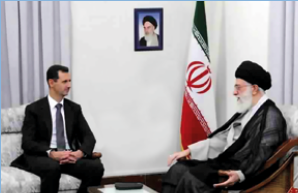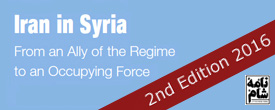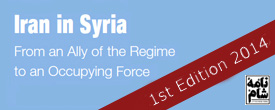I. The Iranian Regime in Syria
With the outbreak of the Syrian revolution in March 2011, the relationship between the Syrian and the Iranian regimes started to change from one of mutually beneficial partnership to one of dependency and dominance. The reason: The Syrian regime would not have been capable of suppressing the mass popular protests in Syria on its own, and would have probably fallen a long time ago if it were not for the Iranian regime’s support. In the words of Iranian Defence Minister Ahmad Vahidi, “Syria is managing this situation very well on its own. But if the government can’t resolve the crisis on its own, then, based on their request, we will fulfil our mutual defense-security pact.”1
This part of the report discusses the main aspect of this support: Sepah Pasdaran’s military involvement in the Syrian war, both direct and indirect, which has effectively kept Bashar al-Assad’s regime in power by force since March 2011, when the Syrian revolution started. It details the role of Iranian commanders and fighters and their possible complicity in war crimes and crimes against humanity committed in Syria. It also looks at Sepah’s role in creating, arming and directing the militias fighting alongside Syrian regime forces, both local and foreign, from the notorious shabbiha to Hezbollah Lebanon and Iraqi Shia militias. Finally, it looks at the supply of Iranian weapons to Syrian regime forces and militias and whether they have been used in known crimes committed in Syria.
Another aspect of the Iranian support to the Syrian regime, spreading pro-regime propaganda through Iranian state-controlled media, is not tackled in this report but has been examined by Naame Shaam extensively elsewhere.2 Economic and financial support are discussed in detail in chapter III.
Of course Iran is not the only regional and international power that has been intervening in Syria. There is also Saudi Arabia, Qatar, Turkey, the US and so on. There is no point in having chicken-or-egg arguments about what was in response to what, but it is worth noting the crucial differences between the Iranian intervention in Syria and that of the so-called Friends of Syria (or of the Syrian opposition, to be more accurate). Unlike the latter, the Iranian intervention is in support of a repressive, murderous regime against people demanding freedom and dignity. It is also much larger in scale and consequences, and is more direct, culminating in a de facto occupation of the country, which is the subject of the next chapter.
Notes & References
1 ‘Defence agreement between Iran and Syria still in place’ (in Persian), Fars News, 22 August 2012. For English, see: Farnaz Fassihi, ‘Iran Said to Send Troops to Bolster Syria’, The Wall Street Journal, 27 August 2012.
2 See Naame Shaam’s ‘propaganda’ tag page, which has various examples of monitoring and debunking Iranian state-controlled media’s propaganda on Syria, including some in-depth case studies.
 English
English  فارسی
فارسی  العربية
العربية 

